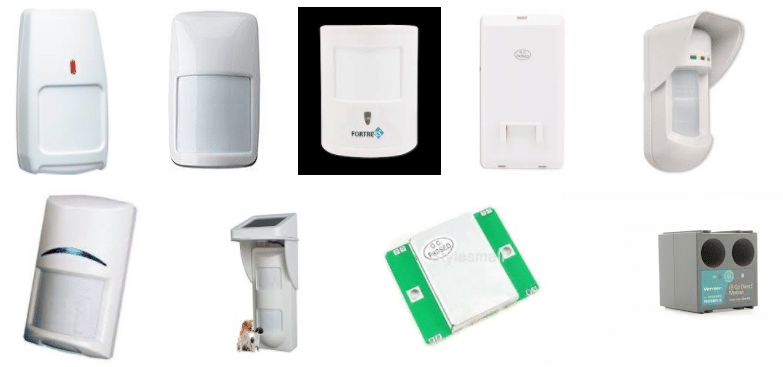
Motion sensors have seamlessly integrated into our daily lives, powering security systems, lighting solutions, and smart technologies. In this in-depth exploration, we’ll unravel the intricacies of how motion sensors operate, shedding light on the technology that has become a cornerstone of modern convenience.
What are Motion Sensors?
Definition and Types
Motion sensors, also known as motion detectors or motion-activated sensors, are devices designed to detect movement in their surroundings. There are various types of motion sensors, including Passive Infrared (PIR), Ultrasonic, Microwave, and Dual Technology sensors, each employing distinct mechanisms to achieve motion detection.
Core Components
- Detector: The detector is the sensing element of the motion sensor. It captures changes in the environment, such as heat, sound, or microwaves, and converts them into electrical signals.
- Processor: The processor, often integrated into the sensor’s control unit, analyzes the signals received from the detector. It interprets these signals to determine whether they indicate motion, triggering the appropriate response.
- Output Device: The output device is the component that reacts to the detection of motion. In lighting systems, this could be a light bulb; in security systems, it might activate an alarm or camera.

How Different Motion Sensors Work
Passive Infrared (PIR) Sensors
- Infrared Radiation Detection: PIR sensors detect infrared radiation emitted by objects. All objects with a temperature above absolute zero emit infrared radiation, and PIR sensors are sensitive to this radiation.
- Calibration: PIR sensors are calibrated to the ambient temperature when in a static state. When an object with a different temperature enters the sensor’s field of view, it causes a change in infrared radiation, triggering the sensor.
- Activation and Duration: Upon detection of motion, the PIR sensor sends a signal to the processor, which activates the output device (e.g., a light). The duration of activation is predetermined and can often be adjusted based on user preferences.
Ultrasonic Sensors
- Ultrasonic Wave Emission: Ultrasonic sensors emit high-frequency sound waves beyond the range of human hearing. These waves bounce off objects in the environment and return as echoes to the sensor.
- Detection of Changes in Echoes: The sensor continuously monitors the echoes. When an object moves, altering the pattern of echoes, the sensor detects this change and triggers the desired response.
- Sensitivity and Adjustability: Ultrasonic sensors typically offer sensitivity adjustments to accommodate different environments and prevent false activations caused by factors like airflow or small objects.
Microwave Sensors
- Microwave Emission and Reflection: Microwave sensors emit low-power microwaves that bounce off objects in the sensor’s range. Moving objects cause a shift in the frequency of the reflected microwaves.
- Doppler Effect: The Doppler effect is utilized to detect motion. Changes in frequency caused by moving objects are analyzed by the sensor, which triggers the activation of the output device.
- Coverage and Penetration: Microwave sensors provide broad coverage and can penetrate obstacles such as walls, making them suitable for various applications. However, careful placement is crucial to avoid unintended detection.
Dual Technology Sensors
- Combining PIR and Microwave/Ultrasonic: Dual technology sensors combine the strengths of different technologies, such as PIR and microwave or PIR and ultrasonic. This fusion enhances accuracy and reduces the risk of false positives.
- Cross-Verification for Enhanced Reliability: By cross-verifying signals from multiple technologies, dual technology sensors improve reliability. Both technologies must register motion for the sensor to activate the output device, minimizing false alarms.
Factors Influencing Motion Sensor Performance
Placement and Orientation
Proper placement and orientation of motion sensors are crucial for optimal performance. Consider the sensor’s field of view, potential obstructions, and the desired coverage area to prevent blind spots or false activations.
Sensitivity Adjustments
Most motion sensors offer sensitivity adjustments to accommodate different environments. Fine-tuning the sensitivity prevents false activations caused by factors like small animals, vegetation, or ambient conditions.
Range Adjustment
Adjusting the range of motion sensors determines the distance at which they can detect movement. Understanding the optimal range for a specific application ensures accurate detection without unnecessary activations.
Response Time
The response time of a motion sensor refers to the duration between detecting motion and triggering the output device. Faster response times enhance the effectiveness of the sensor in providing immediate illumination or activating security measures.
Power Source
Motion sensors can be powered by batteries, electrical wiring, or integrated into smart home systems. The choice of power source depends on factors like accessibility, maintenance requirements, and the desired level of integration.
Environmental Factors
External elements such as weather conditions, temperature changes, and ambient light levels can impact motion sensor performance. Regular maintenance and choosing sensors with weather-resistant features contribute to consistent operation.
Applications of Motion Sensors
Security Systems
Motion sensors play a vital role in security systems by detecting intruders or unauthorized movement. They trigger alarms, cameras, or other security measures to enhance the safety of homes and businesses.
Lighting Systems
In lighting systems, motion sensors activate lights upon detecting movement, providing convenience and energy efficiency. They are commonly used in outdoor lighting, hallways, and areas with sporadic foot traffic.
Smart Home Devices
Motion sensors are integral to smart home devices, contributing to automation and energy conservation. They enable hands-free control of lighting, thermostats, and other connected devices based on user presence.
Industrial Automation
In industrial settings, motion sensors are used for automation, optimizing processes and ensuring safety. They detect movement on production lines, control machinery, and contribute to overall operational efficiency.
Healthcare Applications
Motion sensors find applications in healthcare for patient monitoring, fall detection, and activity tracking. They contribute to creating smart healthcare environments that prioritize patient well-being and safety.
Advanced Motion Sensor Technologies
Infrared Thermopile Arrays
- Enhanced Temperature Sensing: Some advanced motion sensors utilize infrared thermopile arrays, allowing for more detailed temperature sensing. This feature enables the detection of subtle temperature changes, enhancing the sensor’s ability to discern human movement from other heat sources.
LiDAR (Light Detection and Ranging)
- Precise Distance Measurement: LiDAR technology is increasingly integrated into motion sensors for precise distance measurement. This enables applications such as gesture recognition and object tracking, expanding the capabilities of motion sensor systems beyond simple motion detection.
AI and Machine Learning Integration
- Adaptive Behavior: Motion sensors are evolving with the integration of artificial intelligence (AI) and machine learning algorithms. These advancements enable sensors to adapt their behavior based on learning patterns over time, reducing false positives and enhancing overall accuracy.
Conclusion
The ubiquitous presence of motion sensors in our surroundings underscores their significance in enhancing safety, convenience, and efficiency. Whether illuminating a dark hallway, securing a home, or contributing to the automation of industrial processes, motion sensors exemplify the seamless integration of technology into our daily lives.
Understanding the inner workings of motion sensors, the different technologies employed, and the factors influencing their performance empowers users to make informed choices when implementing these devices. As technology continues to advance, the role of motion sensors in shaping intelligent and responsive environments is poised to expand, promising a future where our surroundings intuitively adapt to our presence.
Elevate your projects with MLVOLT, a leading PCB design company and sensor design company committed to excellence. Explore our comprehensive services, blending precision and innovation. Visit our services page for tailored solutions that transform your ideas into exceptional electronic realities.

Founder of MLVOLT & Ex- Ex-Marketing Manager of MBA CHAI WALA